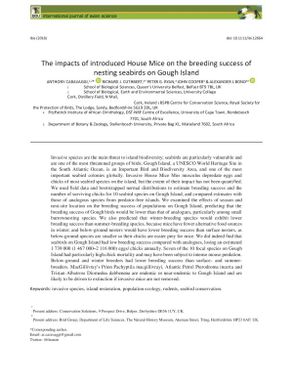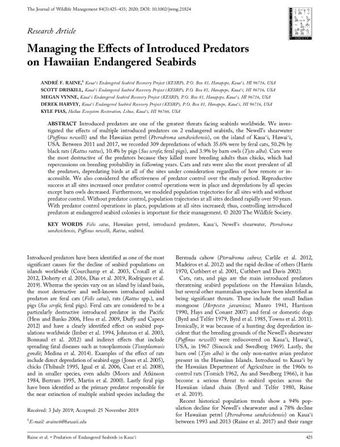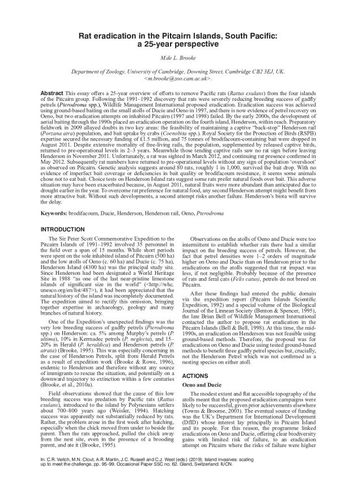The impacts of introduced house mice on the breeding success of nesting seabirds on Gough Island
- Description:
- Invasive species are the main threat to island biodiversity; seabirds are particularly vulnerable and are one of the most threatened groups of birds. Gough Island, a UNESCO World Heritage Site in the South Atlantic Ocean, is an Important Bird and Biodiversity Area, and one of the most important seabird colonies globally. Invasive House Mice Mus musculus depredate eggs and chicks of most seabird species on the island, but the extent of their impact has not been quantified. We used field data and bootstrapped normal distributions to estimate breeding success and the number of surviving chicks for 10 seabird species on Gough Island, and compared estimates with those of analogous species from predator-free islands. We examined the effects of season and nest-site location on the breeding success of populations on Gough Island, predicting that the breeding success of Gough birds would be lower than that of analogues, particularly among small burrownesting species. We also predicted that winter-breeding species would exhibit lower breeding success than summer-breeding species, because mice have fewer alternative food sources in winter; and below-ground nesters would have lower breeding success than surface nesters, as below-ground species are smaller so their chicks are easier prey for mice. We did indeed find that seabirds on Gough Island had low breeding success compared with analogues, losing an estimated 1 739 000 (1 467 0002 116 000) eggs/ chicks annually. Seven of the 10 focal species on Gough Island had particularly high chick mortality and may have been subject to intense mouse predation. Below-ground and winter breeders had lower breeding success than surface- and summer-breeders. MacGillivrays Prion Pachyptila macgillivrayi, Atlantic Petrel Pterodroma incerta and Tristan Albatross Diomedea dabbenena are endemic or near-endemic to Gough Island and are likely to be driven to extinction if invasive mice are not removed.
- Display date:
- 2018
- Collections:
- Secretariat of the Pacific Regional Environment Programme (SPREP)
- Publisher:
- The Natural History Museum
- Content partner:
- Secretariat of the Pacific Regional Environment Programme (SPREP)
- Availability:
- Not specified
-
Copyright status: All rights reservedFind out more about what you are able to do with this itemThis item is all rights reserved, with means you'll have to get permission from Secretariat of the Pacific Regional Environment Programme (SPREP) before using it. For more information, please see our use and reuse page.What can I do with this item?Non-infringing useNZ copyright law does not prevent every use of a copyright work, and this item may be hosted by an international institute or organisation. You should consider what you can and cannot do with a copyright work.No sharingYou may not copy and/or share this item with others without further permission. This includes posting it on your blog, using it in a presentation, or any other public use.No modifyingYou are not allowed to adapt or remix this item into any other works.No commercial useYou may not use this item commercially.
Related items
Welcome and warm Pasifik greetings
The information on this site has been gathered from our content partners.
The names, terms, and labels that we present on the site may contain images or voices of deceased persons and may also reflect the bias, norms, and perspective of the period of time in which they were created. We accept that these may not be appropriate today.
If you have any concerns or questions about an item, please contact us.


